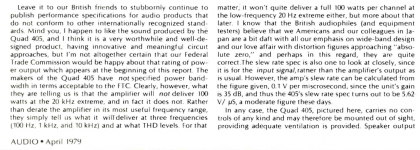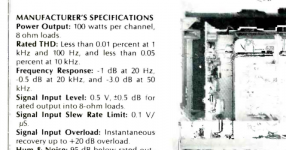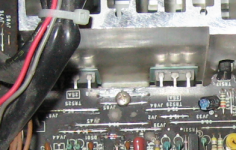How good are 1970s-1980s solid state amps if properly restored (all electrolytics and noisy transistors and diodes replaced, etc.)?
I'm referring to Sansui, Accuphase, Kenwood, etc., particularly their top of the line models.
Did they suffer from poor sound on average due to excessive (and poorly implemented) global feedback to achieve low distortion ("the THD wars"), or are they as good as modern amps if properly restored as far as circuit technology?
I'm referring to Sansui, Accuphase, Kenwood, etc., particularly their top of the line models.
Did they suffer from poor sound on average due to excessive (and poorly implemented) global feedback to achieve low distortion ("the THD wars"), or are they as good as modern amps if properly restored as far as circuit technology?
Just completed an update to an amp from 1990. The improvement is substantial, and I might post the mods at some point. Some amps had good basic topology and lost out on two main things - lack of simulator as a design tool and slow output devices.
Restoration is only for units that have intrinsic value unaltered. With modification, some units will perform very well. For this you will need a simulator like LTspice and of course the schematic. If you pick wisely the end result will compete with modern gear.
Methods for stability compensation in 1970 seem limited. Using modern techniques HF distortion can be reduced by a factor of ten. Altering compensation costs pence.The end result is a new amp, sounding very different from the original. Amps as far back as 1970 will need scrutiny before diving in, but the JLH 1969 has been updated and is going strong.
Restoration is only for units that have intrinsic value unaltered. With modification, some units will perform very well. For this you will need a simulator like LTspice and of course the schematic. If you pick wisely the end result will compete with modern gear.
Methods for stability compensation in 1970 seem limited. Using modern techniques HF distortion can be reduced by a factor of ten. Altering compensation costs pence.The end result is a new amp, sounding very different from the original. Amps as far back as 1970 will need scrutiny before diving in, but the JLH 1969 has been updated and is going strong.
I'm referring to Sansui, Accuphase, Kenwood, etc., particularly their top of the line models.
Just a question. Why are you guys modding vintage amps to make them sound differently?
I've recently bought a Quad clone, based on the early 1975 model. Thinking I would mod it, for different performances. But at low wattages, it sounds great using it as is.
I've a Denon of the 80's needing recap. I wouldn't do much more on that one.
I think you missed the point. Old amps may have engineering deficiencies. Fixing these improves the sound, and in terms of bang for buck, is the lowest cost route for an extremely high quality amp.
If you examine technical evaluations of modern units, class D is making progress. Conventional AB design has plateaued in commercial offerings. There are better designs on this forum.
If you examine technical evaluations of modern units, class D is making progress. Conventional AB design has plateaued in commercial offerings. There are better designs on this forum.
The case of the 1975 Quad was discussed in an early paper I found on the internet. Conclusion of experts was: excellent amp up to 2x50W, not recommanded as it wasn't at 0,01% distortion over full 20-20k range at 2x100W.
After 3 weeks of listenings with that Quad, I swapped it for a 0,05% recent modfet. I quickly perceived subtile differences in high trebles, on attacks, then I accomodated. A few hours later, I swaped back to the Quad.
I'm thinking about modding the mosfet to meet the 1975 era Quad 🙂
After 3 weeks of listenings with that Quad, I swapped it for a 0,05% recent modfet. I quickly perceived subtile differences in high trebles, on attacks, then I accomodated. A few hours later, I swaped back to the Quad.
I'm thinking about modding the mosfet to meet the 1975 era Quad 🙂
Attachments
What do these experts make of modern day audio jewelry that cannot make 0.01% @ 20KHz even at 10W?
What do these experts make of modern day audio jewelry that cannot make 0.01% @ 20KHz even at 10W?
Considering this review was from 1979, I suppose they'd need to jump in a time machine first 🙂
What do these experts make of modern day audio jewelry that cannot make 0.01% @ 20KHz even at 10W?
Maybe related? I had a look at some tracks which sounded slightly different to me with the mosfet, any of the shelf amp promoted as "0,05% at 10W 1kHz".
Listening, the mosfet output seemed some how confused on attacks in trebles. Other trebles being acceptable with either amp.
Is this related to distortion in those frequencies?
Attachments
Last edited:
No time machine. Unless they are all dead. I was around for the original Quad article. Read some old reviews to get idea of what was fashionable.
From 1998
"Many people believe that the best-sounding solid-state amps are those that use only one pair of transistors per channel"
To get back on topic. Pick a candidate and see what opinions it throws up. We will need to see schematic.
From 1998
"Many people believe that the best-sounding solid-state amps are those that use only one pair of transistors per channel"
To get back on topic. Pick a candidate and see what opinions it throws up. We will need to see schematic.
From 1998
"Many people believe that the best-sounding solid-state amps are those that use only one pair of transistors per channel"
Wasn't aware of that. Now found only that sentence in a Stereophile paper promoting a precise amp.
I only naively compared two amps on attacks, listening, both having one pair in their outputs 🙂
I've being doing restorations and modifications to old amps for the last decade. Many really are worth the effort.
After a while a pattern emerges of common mistakes or cost savings, different brands doing things a certain way, changes as brands change ownership, etc.
There is so much help available on the internet: service manuals, tech notes, experience from other owner, etc, etc. Good amplifiers have strong followings, so an internet search can be a good guide to what's worth spending time on. Of course the better vintage amps hold their value and command higher secondhand prices.
My amp is a Accuphase E-303x from mid '80s and I have no reason to change it anytime soon. They are selling in the multi-thousands price range these days.
After a while a pattern emerges of common mistakes or cost savings, different brands doing things a certain way, changes as brands change ownership, etc.
There is so much help available on the internet: service manuals, tech notes, experience from other owner, etc, etc. Good amplifiers have strong followings, so an internet search can be a good guide to what's worth spending time on. Of course the better vintage amps hold their value and command higher secondhand prices.
My amp is a Accuphase E-303x from mid '80s and I have no reason to change it anytime soon. They are selling in the multi-thousands price range these days.
How good are 1970s-1980s solid state amps if properly restored (all electrolytics and noisy transistors and diodes replaced, etc.)?
Imo those amps generally cannot compare to even today's midfy, not to mention real high end stuff.
It's not just capacitors or the odd transistor, the old amps generally have tone controls, a multitude of signal line switches, most of which gone bad, blackened relay contacts, horrible speaker and rca termination, inadequate power supplies.
Perhaps out of that entire period, there are just a few amps worth having today. A Naim NAP250 is the first piece readily coming to my mind and of course the Electrocompaniet Otala amp. And the Levinson ML2.
There were certainly some great amps on the Japanese domestic market, but the rest of the world only learned about those much later. The mass produced stuff was so bad that even the Quads were considered good sounding at the time.
I guess it depends what one means by "amp", to me that means a dedicated power amp but integrated amps were also popular at the time and of course there were recievers too.
Japan produced some of it's best solid state amplifiers in this '70/80's era.. some of which are only now getting proper recognition. Examples of would incudes the Sansui AU-xxx integrated amp series and the Yamaha M series of power amps, I bought a AU-D5 brand new in '78 and have a AU-717 here now that needs a restoration, and I also have a Yamaha M-85 that ranks as one of the best sounding amplifiers I have ever heard, besting a first generation Bryston 4B that I had for a few years.
There were a lot of ho hum products too of course, I was never impressed with any mass market reciever from that era and there were a lot of me too products that looked the biz but just didn't deliver. A great example of that were the Nikko Alpha series of power amplifiers, my neighbor had an Alpha 220 with the matching preamp, it worked well enough into 8ohms but would shut down when loaded to 4ohms. Another friend of mine had a Alpha 440, it was a beast but I never got to do any critical listening on it.
Japan produced some of it's best solid state amplifiers in this '70/80's era.. some of which are only now getting proper recognition. Examples of would incudes the Sansui AU-xxx integrated amp series and the Yamaha M series of power amps, I bought a AU-D5 brand new in '78 and have a AU-717 here now that needs a restoration, and I also have a Yamaha M-85 that ranks as one of the best sounding amplifiers I have ever heard, besting a first generation Bryston 4B that I had for a few years.
There were a lot of ho hum products too of course, I was never impressed with any mass market reciever from that era and there were a lot of me too products that looked the biz but just didn't deliver. A great example of that were the Nikko Alpha series of power amplifiers, my neighbor had an Alpha 220 with the matching preamp, it worked well enough into 8ohms but would shut down when loaded to 4ohms. Another friend of mine had a Alpha 440, it was a beast but I never got to do any critical listening on it.
The mass produced stuff was so bad that even the Quads were considered good sounding at the time.
My Denon PMA 860 was not that bad. After some 20 years, its volume pot started to crackle...
The mass products featuring some extras you won't see in your HiFi range 🙂
Attachments
And relays too.It's not just capacitors or the odd transistor, the old amps generally have tone controls, a multitude of signal line switches, most of which gone bad, blackened relay contacts, horrible speaker and rca termination, inadequate power supplies.
I wonder if transitors age too degrading performance ? Also want to know most vintage amp had Mains in, which bypasses volume control, tonecontrol switches etc. If it would be somewhat better ?
Dont know why some modern integrated amplifiers discard mains in / pre out. So one can use its preamp or power amp.
Also wanted to know most modern amps have some digital/IC based input selection and tone control / bypass.. do they degrade performance being in the circuit ?
Regards.
Edit : Sorry you already manetioned relays.
Last edited:
The ones I have seen had mains switches to transformer primary.
And expecting 40 year old equipment not to age is not reasonable.
See your face in the mirror, see your old photos...
That said, there is data on transistor and capacitor life, and unless you had it a long time, you do not have an idea how it was used or abused.
Like an old car, stick to one that looks cared for.
And see if genuine parts are available.
Digital selection is used because remote integration is easier, and those ICs do not age or wear out. Sound quality may be degraded.
And expecting 40 year old equipment not to age is not reasonable.
See your face in the mirror, see your old photos...
That said, there is data on transistor and capacitor life, and unless you had it a long time, you do not have an idea how it was used or abused.
Like an old car, stick to one that looks cared for.
And see if genuine parts are available.
Digital selection is used because remote integration is easier, and those ICs do not age or wear out. Sound quality may be degraded.
Anglo-Japanese noname 70s amplifier was discussed here.
Small transformer, small heatsink, output power 20 W.
Small transformer, small heatsink, output power 20 W.
Older amps had the advantage of low capacitance transistors. The one just modded had in one package, matched transistors with Cob of 2pF.for the input device. It makes a big difference in how the circuit could perform. Designs failed to capitalize in many cases, which is why a revisit can reap benefits.
Newer amps have nice clothes but in majority, the engineering hasn't changed much. You can tell that from the hockey stick curves of the distortion plots. The less rigorous testing still results in a number breaking on the test bench or have mismatched channel performance. Consumers are asked to swallow this as 'artisan build'. Audiophiles don't like cheaper products that perform well. They also don't like small. I have seen both of those in print.
Newer amps have nice clothes but in majority, the engineering hasn't changed much. You can tell that from the hockey stick curves of the distortion plots. The less rigorous testing still results in a number breaking on the test bench or have mismatched channel performance. Consumers are asked to swallow this as 'artisan build'. Audiophiles don't like cheaper products that perform well. They also don't like small. I have seen both of those in print.
- Home
- Amplifiers
- Solid State
- Vintage SS Amps



